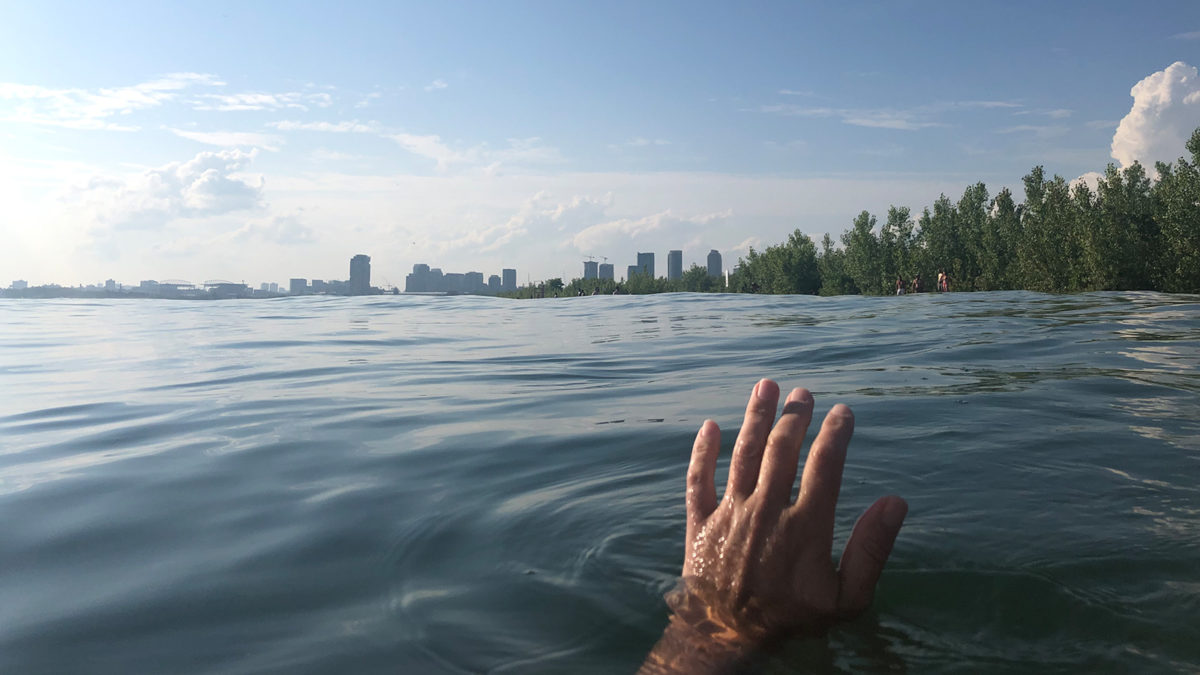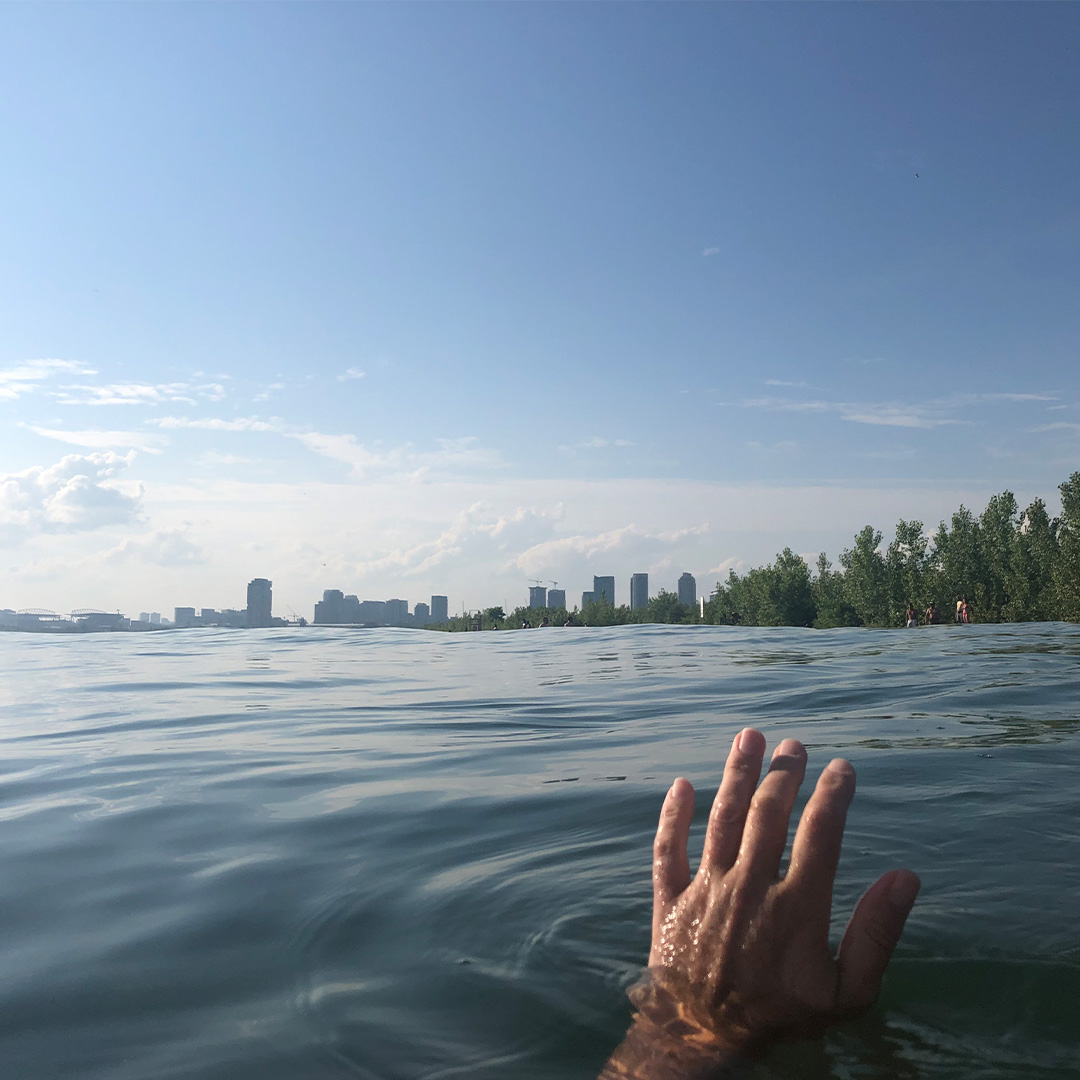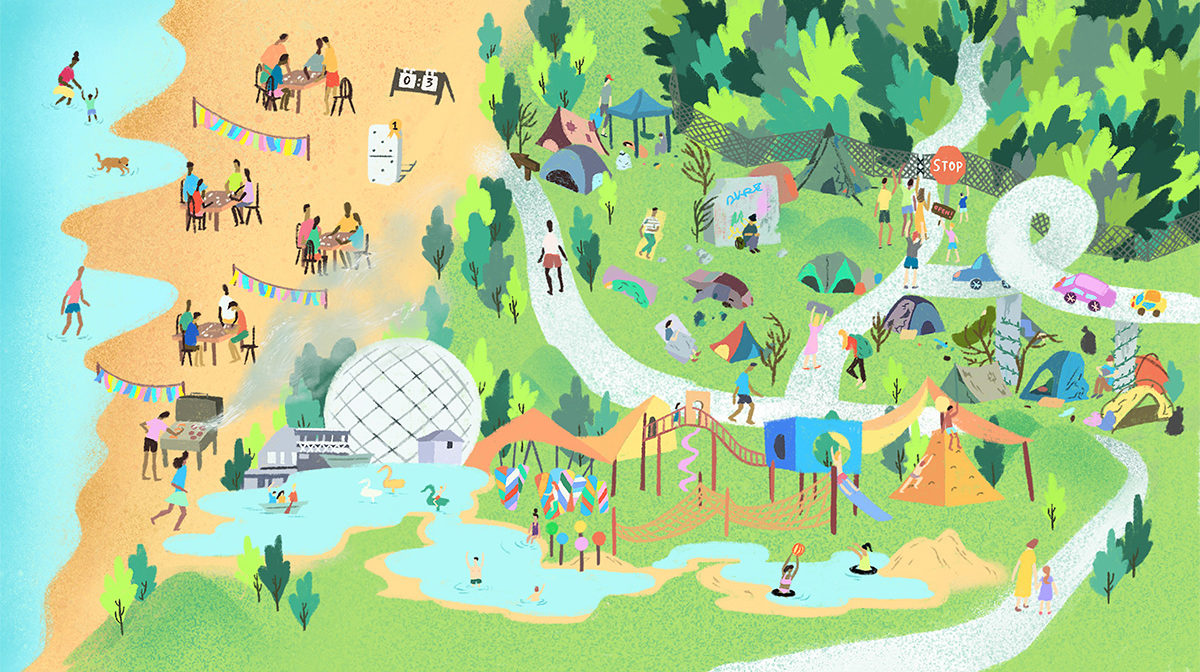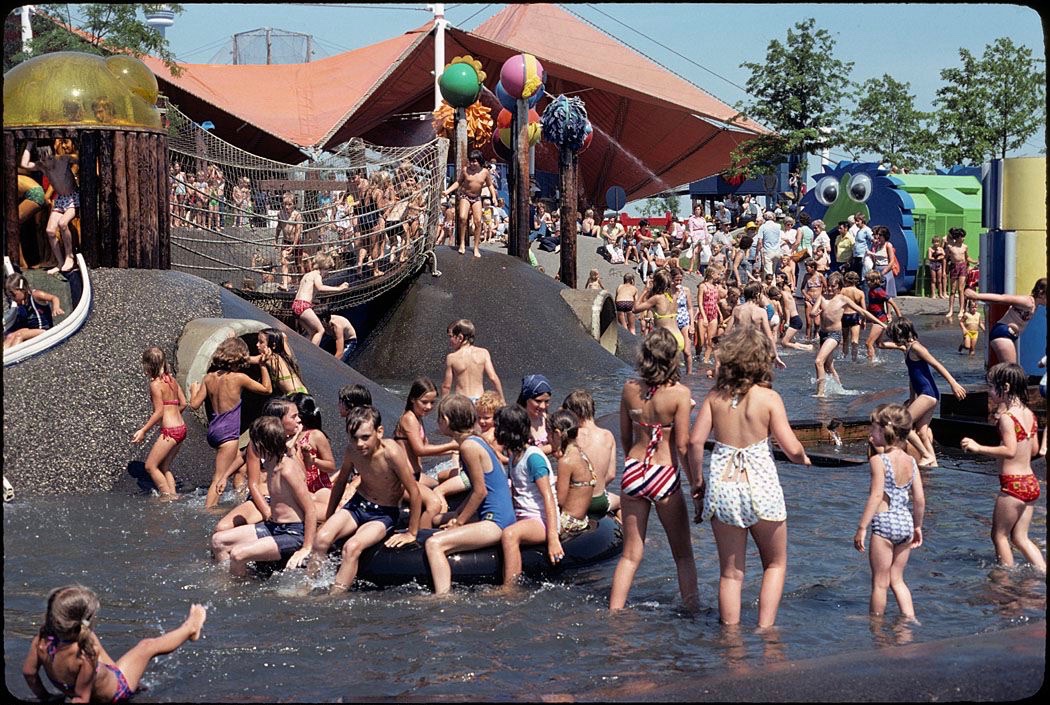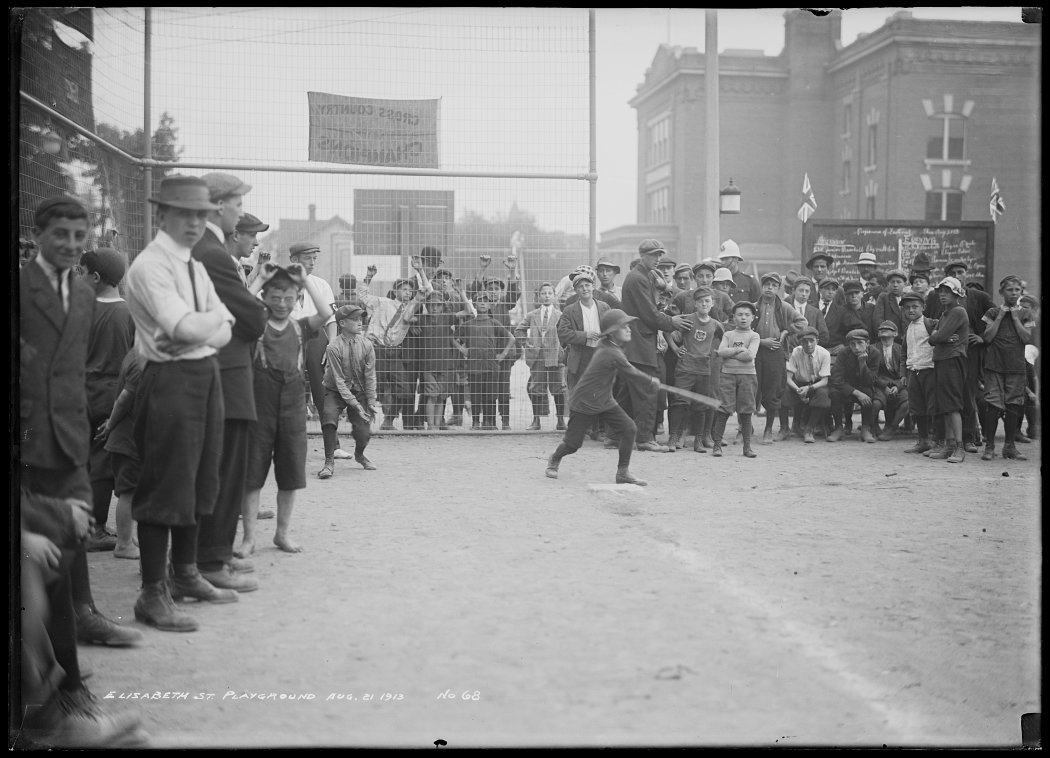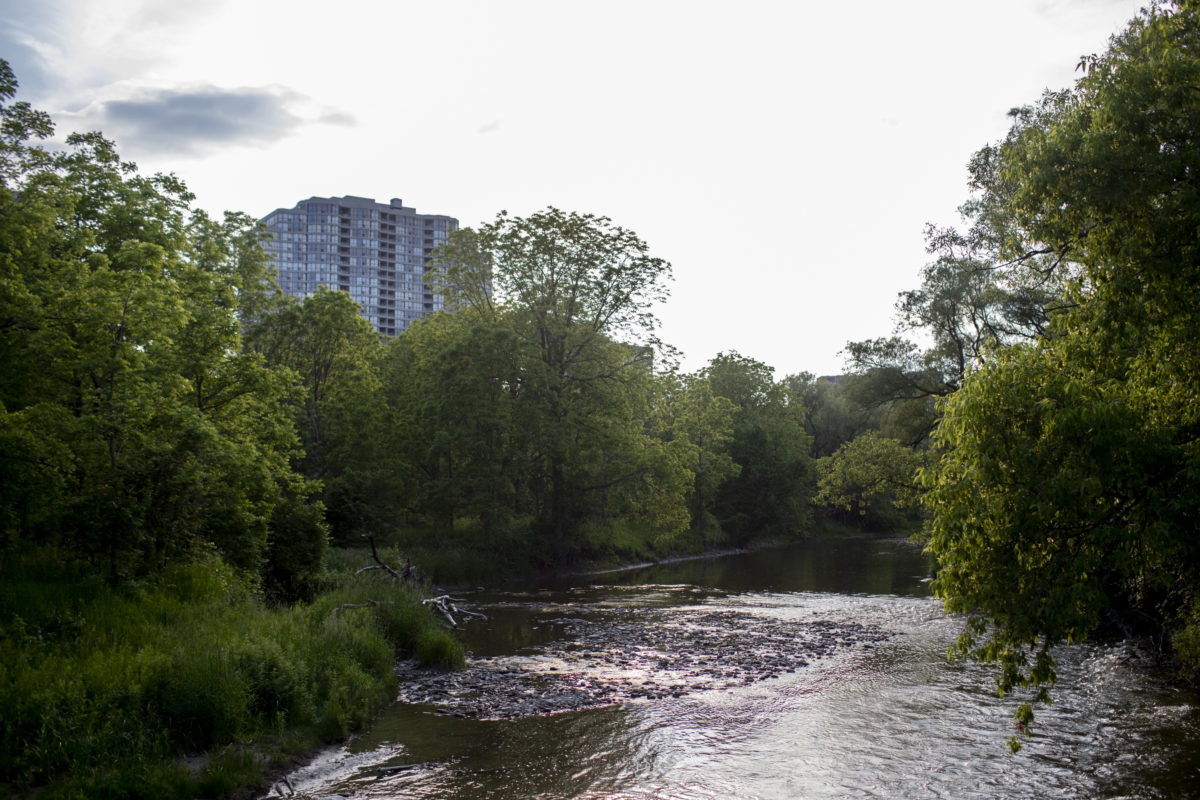In 1964, John Cheever published The Swimmer, a short story about Neddy Merrill, an upper middle-class guy who decided to “swim” across the posh suburbs he lived in via its backyard pools. Later made into a movie starring Burt Lancaster and his well-fitted swimsuit, it takes a dystopic turn and is a social commentary of much more than Connecticut swimming pools. Today, with so many clean beaches, a much happier version of Neddy’s marathon could be replicated in Toronto.
A few weeks ago, I had a thought to do just this, to swim the beaches from the Mississauga to the Pickering border. But while it could be done, portaging overland from one to another, it would be an all-day, rushed affair. Toronto is 44 km wide, and if you factor in the Toronto Island beaches, this particular local marathon would be upwards of 50 km. Part of the joy of going to the beach is spending time there.
Instead, spread over a week as weather allowed, I biked various stretches of Toronto’s coastline to see who’s at the beach, check the beaches themselves, and see if swimming culture has evolved here. Has Toronto embraced its beaches?
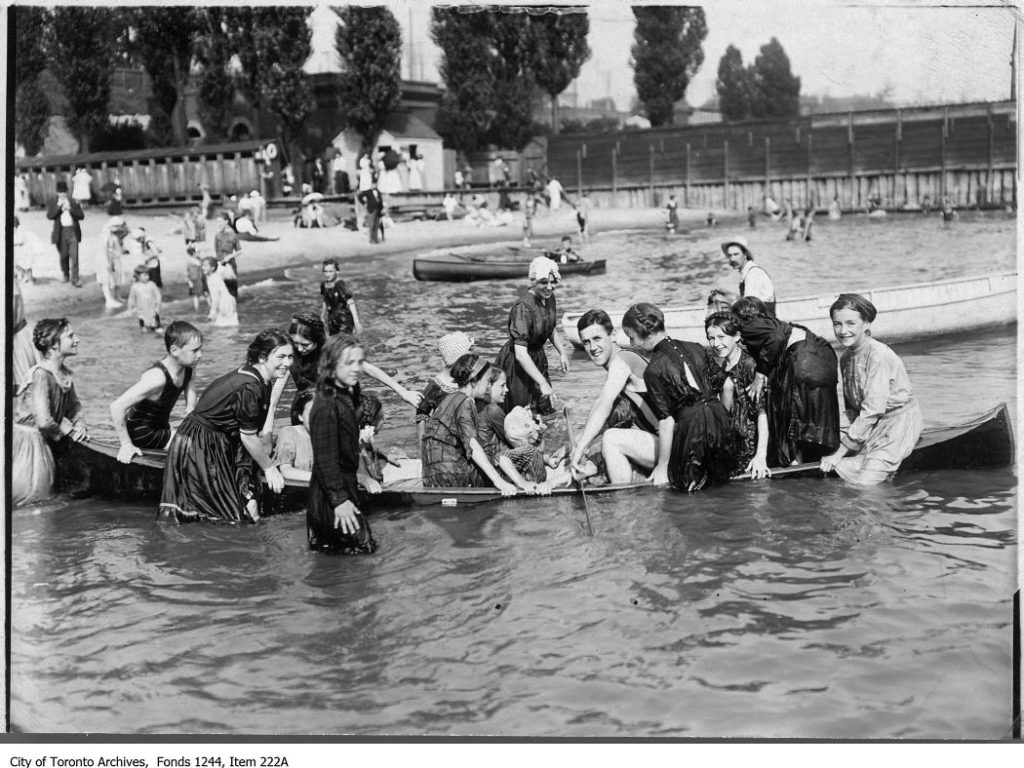
I ’ve been swimming from Toronto beaches for nearly two decades, but my first visit to a Toronto beach was not a good day.
Summer arrived not long after I moved to the city in 2000, and by then I’d seen the fantastic, almost fantastical, archival black and white photos of Sunnyside Beach from nearly a century before. In these photos, the beach is jammed with hundreds, maybe thousands, of people in their woollen bathing costumes. In some pictures hardly a bit of sand was visible for the crowds. The resplendent Sunnyside Bathing Pavilion was visible in some pictures, a beauty designed to look like a Roman bath that honoured swimming in Lake Ontario as if it were the Mediterranean.
Lake Ontario is not the Mediterranean, of course, even if the turquoise-coloured waters sometimes bear a resemblance. It is a lake so deep and cold its water is used to cool buildings downtown in the summer. It does not warm quickly like the smaller cottage country lakes well north of the city, and even weeks into July it can be so bone-chilling that limbs will ache after just a few moments. That chill led to the opening of what is now called the Sunnyside Gus Ryder pool in 1925, a massive, lake-sized tank that still welcomes hundreds of swimmers at a time, just like those crowded beach photos of old, only with much more skin showing now.
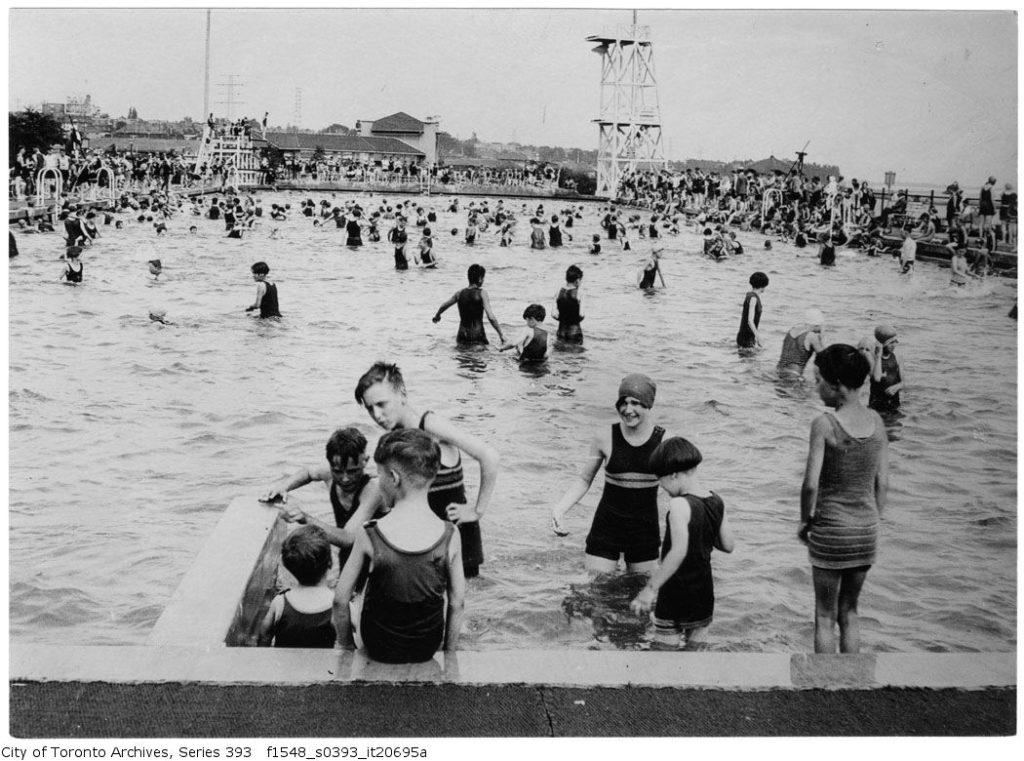
Concrete break walls were also built a few dozen meters offshore in an effort to warm up the water for swimmers. If the lake had a tide, this sheltered water might flush out twice a day. But, as it doesn’t, the walls have had the effect of limiting water circulation so it’s often murky and stale. Such was the state of the water on that very hot summer day when I first visited. I had packed a little towel, worn a bathing suit under my shorts, and walked over the pedestrian bridge at the foot of Roncesvalles Avenue and west along the waterfront. I expected to spread that towel out and jump in as one does at the beach, but the water was not inviting.
Though I love open-water swimming, even the slightest hint of murk can turn me off, and Sunnyside often has just enough of that. Murk doesn’t necessarily mean the water is truly dirty, though Sunnyside often suffers from high E. coli levels, most often after heavy rain and thunderstorms when the combined sanitary and stormwater sewers are overwhelmed and spill into the lake. It used to be much worse, but in recent years massive efforts that include underground storage tanks have mitigated the effects proving that environmental regulations and infrastructure pay off. Still, led by Mayor Tory, Toronto City Council balked on implementing a stormwater management fee that would have incentivized property owners to install permeable surfaces so water could be absorbed where it fell rather than running into sewers.
It’s somewhat ironic then that the most architecturally impressive beach is one that isn’t the most swimmable. The busy pool is a testament to the desire to swim, and the beach itself will have many sunbathers on sunny days, and the grassy park behind it crowded with extended families and big groups on weekends and holidays, but not many are in the lake. In Toronto, there is a tension between a desire to swim and the water itself, whether its temperature or quality issues. Despite the storm overflow days, Lake Ontario is dramatically cleaner than it was just a few decades ago and eight beaches within the city limits are flying the Blue Flag this year, an international program that annually evaluates beaches using 33 criteria including water quality, environmental education, environmental management, safety, and services. The reputation that it’s dirty clings and has been hard to shake, however, especially for those old enough to remember the very dirty years up to and around 1990, when Ryerson student Jeremy Lynch infamously developed photographs using water from Lake Ontario.
This year, like in 2017, the extreme high water level in the lake has affected all of Toronto’s beaches. On this particular odyssey I also didn’t make to the farthest beaches on either side of the city, Rouge in the east and Marie Curtis Park in the west, often quite popular, though neither were awarded a Blue Flag this year. I started in the middle, at Hanlan’s Point Beach, where I first learned lake swimming in Toronto is great and glorious.
Hanlan’s isn’t what it used to be, though, when I “discovered” it not long after that first Sunnyside trip. For the last decade, what was once an expansive, triangular swath of beach has steadily eroded away, each season a little smaller than before. Compounding that erosion, this year’s high water has created large lagoons behind a thin sliver of beach, leaving little space for beach-going. Still, on a sunny Monday in July there were dozens of people out, and the water was clean.
Since 1999, about half of Hanlan’s has been Toronto’s only clothing-optional beach, and since at least the early 1970s, when the first of what would evolve into Toronto’s Pride celebrations were held here, it’s also been a special spot for Toronto’s queer community. Somewhat isolated from the rest of the island and the city itself, this is Toronto at its most libertine, and on busy weekends the scene is jammed, music is playing, and it’s a party atmosphere in parts, though it’s quieter closer to the airport. The militant nudists sometimes make it known they’d like everyone clothes off, but it’s a be-who-you-are place and my favourite spot in the city.
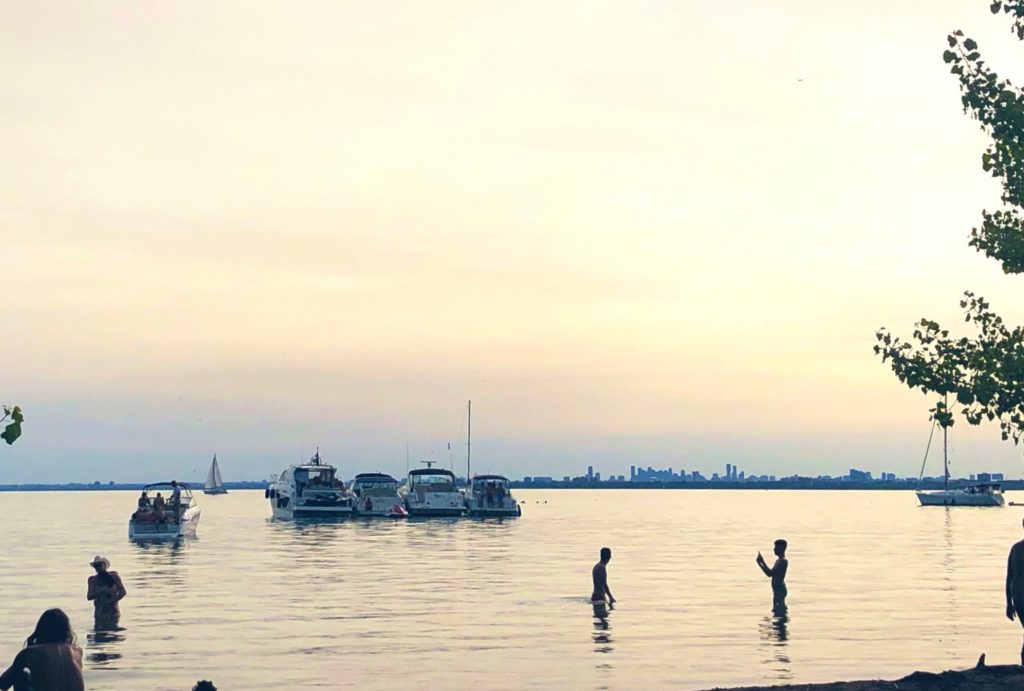
The sunsets at Hanlan’s are unmatched in Toronto, and the last few hours of daylight are some of the most tranquil and sublime times I’ve spent in this city, when the turquoise waters become glassy. On this particular Monday, and on a return visit the next Saturday, the water was warm and easy to get into. While there weren’t a lot of swimmers in the water, I swam a few hundred meters up and down the shoreline. One annoyance at Hanlan’s is that only part of it has buoys marking areas that are off-limits to watercraft, meaning the swimming area becomes a parking lot for boats that leave a sheen of oil on the water. The entire beach needs to be reserved for swimmers. The erosion of so much of the clothing-optional section should also result in moving the dividing line further along the beach, or making the entire beach clothing optional. The standing water has also been breeding a lot of mosquitos this year, bumps I was itching for days afterward. Still, I will return as many times as this summer allows.
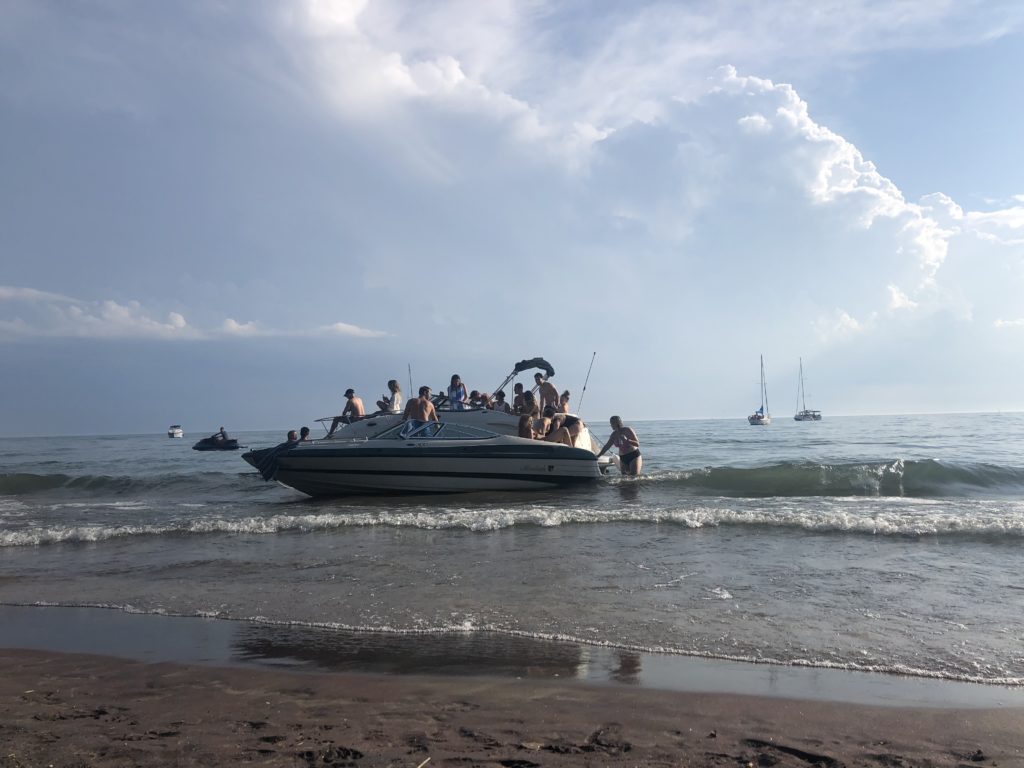
The other three beaches on the island are smaller this year too but haven’t suffered as badly as Hanlan’s has. Behind the Gibraltar arts centre, Gibraltar Point Beach is still far enough from the Centre Island crowds that it shares some of Hanlan’s isolated feeling. Both Centre and Wards beaches are kid and family favourites, as both are relatively close to ferry docks. Wards, with the cute and rustic island homes on the way to it, has the added benefit of feeling like you’re walking to a beach in cottage country down a shady lane. The island has the ability to feel like it’s someplace far from Toronto, even if the city is always within sight.
Back on the mainland, there are two urban beaches along Toronto Harbour, HTO Park and Sugar Beach, both incredibly popular, highly designed places that are both off-limits to swimming. However, along the increasingly dense Mimico waterfront another artificially created beach has the potential to be a proper one. Both of Humber Bay Park’s peninsulas on the east and west side of Mimico Creek were created by dumping fill into the lake between the 1960s and 1980s. They’ve naturalized over time and today there are semi-sandy beaches that have formed with chunks of rock, concrete, and the occasional bit of rebar. When I rode by on a warm Tuesday there were people sunbathing and even two doing a bit of swimming. As this was once an open lake, the water gets deep quickly. With a little work clearing up the rebar and such this could be a functional beach at the doorstep of the tens of thousands of people who live just a few minutes away now.
A similar artificial beach can be found on the edge of Ontario Place, behind what was once the wilderness adventure ride. Though somebody has removed the “No Swimming” sign that was there, it too has the potential to be a swimmable place on the edge of downtown. Imagine if a floating “swimming pier” were extended into the clean water here, similar to the popular one installed last year in downtown Kingston. When I rode by, there were dozens of day camp kids playing on the beach, looking at rocks, but none venturing into the water of course.
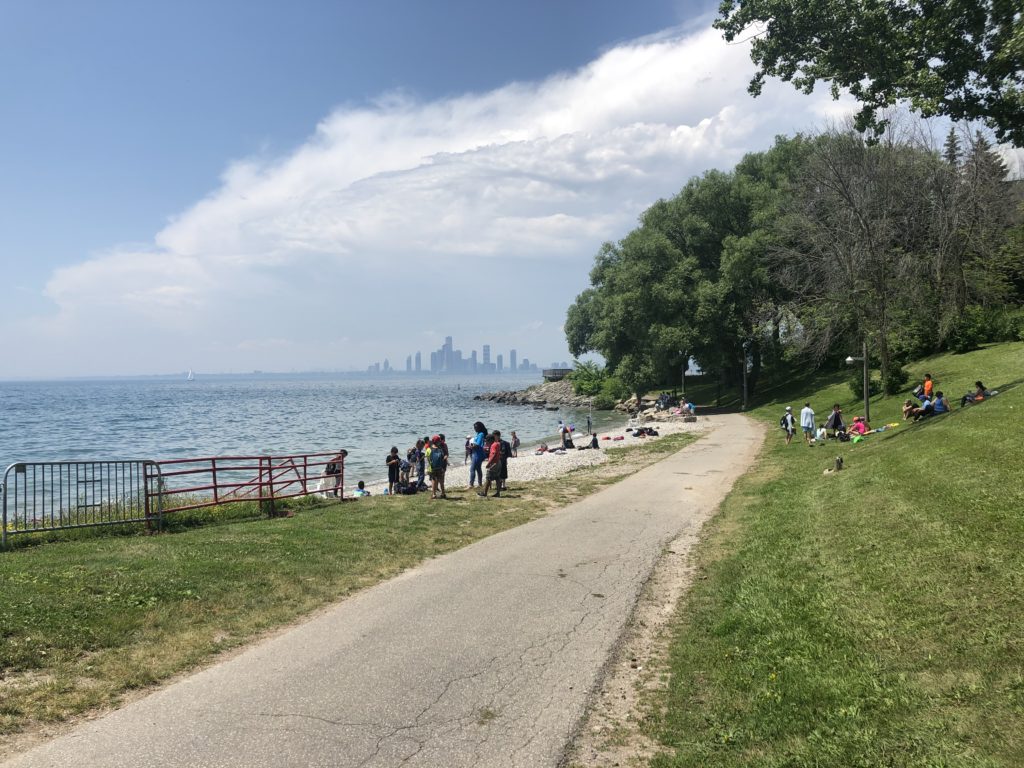
Even the land that looks like it’s always been there can be artificial in Toronto. At Sunnyside, the lakeshore was once right up by the railway corridor until the “Sunnyside Reclamation Project” in the early 1920s added nearly 197 acres of land between the Humber River and Bathurst Street with topsoil taken from a 96-acre farm in Pickering. Though I swam lengths in the pool when I visited that day, there were a few people swimming in the lake, followed closely by lifeguards who hovered nearby in their dory boats, a particular-to-Toronto thing that I’ve not seen at beaches elsewhere. While I appreciate their service, a bit of space is nice.
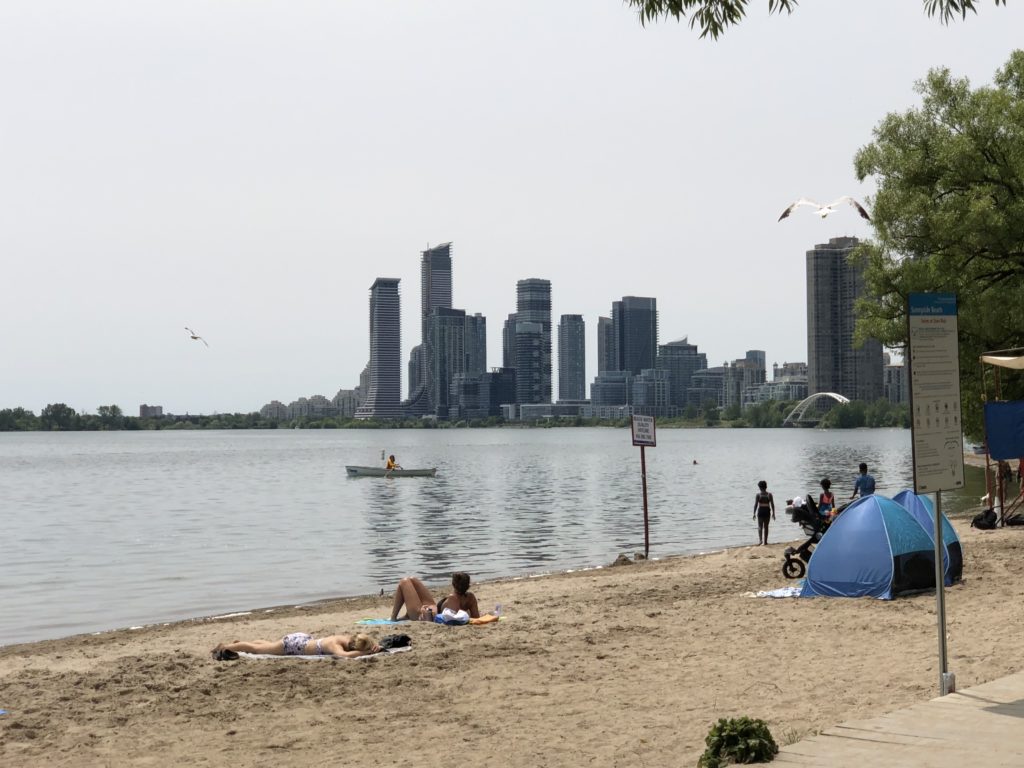
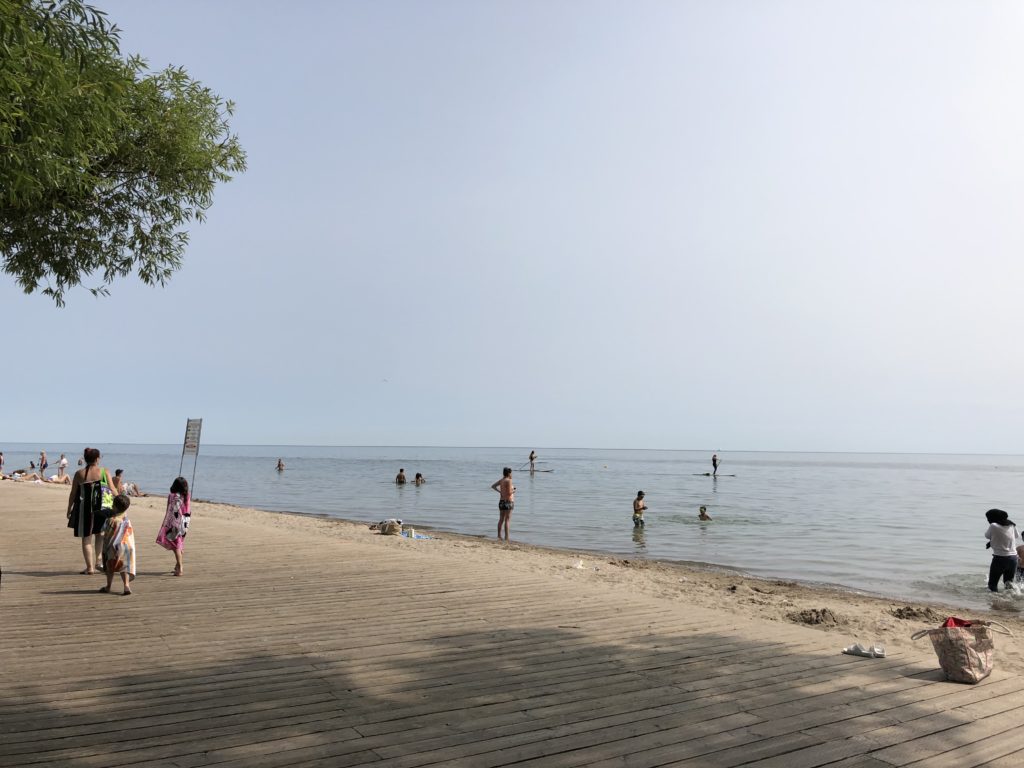
The other beach closest to downtown is Cherry in the Portlands. Like the island beaches, it flies the Blue Flag this season and on my visit a young man was swimming up and down the shoreline, followed closely by a rowing lifeguard, of course. While the water is clean, the beach at Cherry isn’t in great shape: always a bit rocky and dusty, and there are several swampy ponds that have yet to drain completely due to flooding, creating more breeding areas for mosquitos. A few truckloads of sand could fix this. At the western end of the beach is the vast dog run, so amphibious-minded canines also have their own place to swim and cool down.
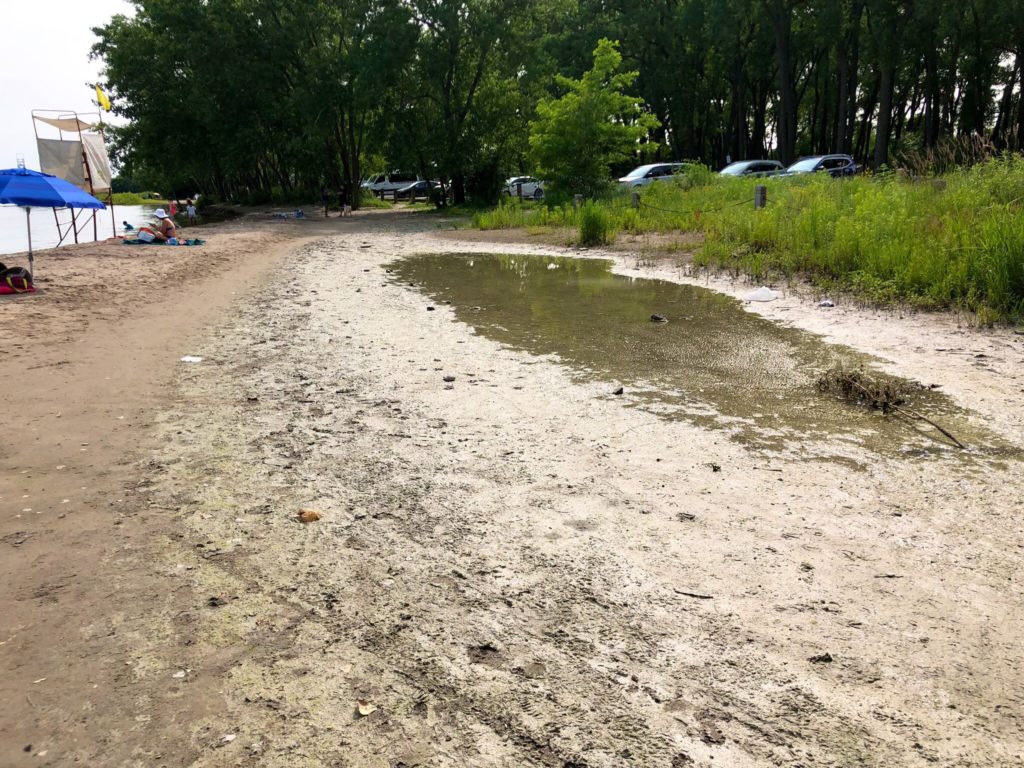
Another dog beach exists in the Beaches neighbourhood, in between the beaches that give the neighbourhood its name, Woodbine and Kew-Balmy. Woodbine is a massive, almost California-scaled beach with dozens of volleyball nets. Though it was easy to swim at Hanlan’s the day before, Woodbine was limb-numbingly cold. The lake is a mystery and its temperature turns as it wishes. Few ventured in for more than a moment, though it was quite hot out. The scene here is also a bit of a party, with space for big groups of teenagers and families too. Further east, the Kew-Balmy beach strip is a bit quieter, with coves created by break walls that make for smaller swimming holes. Despite the high water, there’s still a lot of beach here.
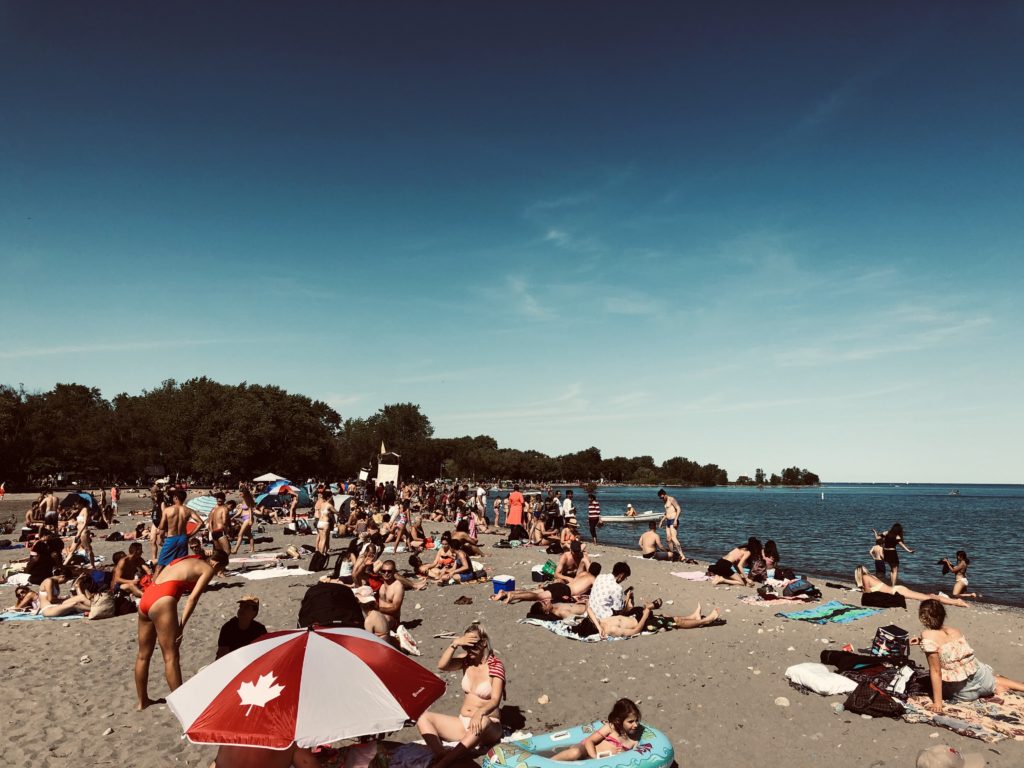
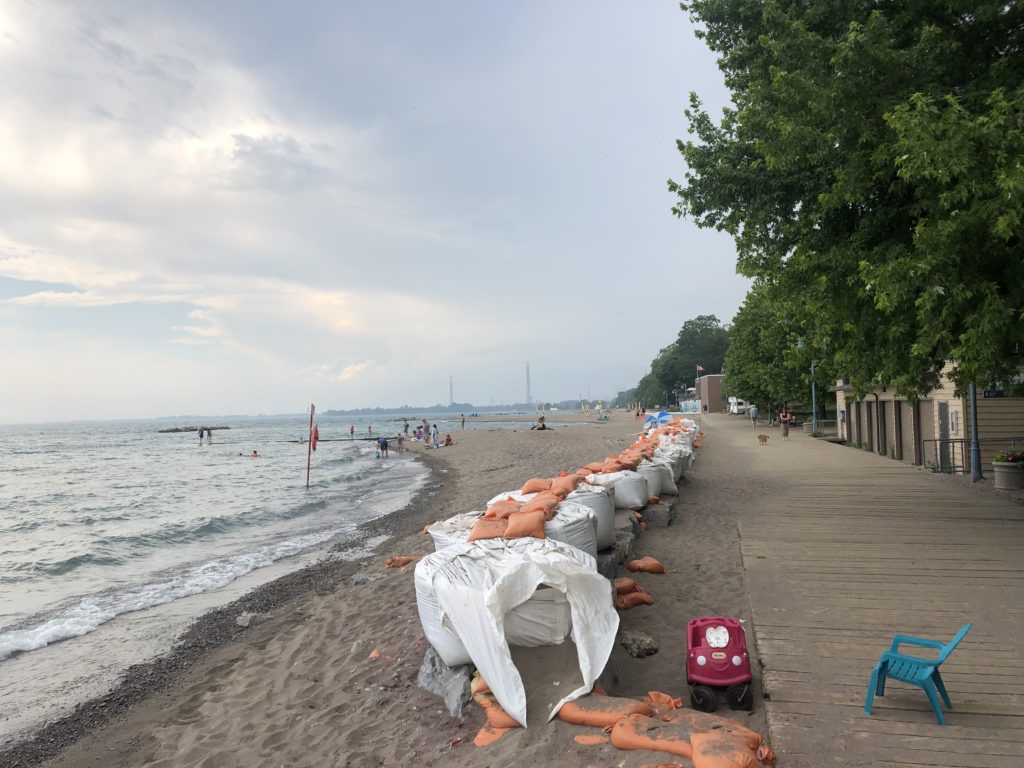
The final beach I visited was Bluffers, a long ride from the west side of the city but worth the effort. Getting there without a car is difficult. The beach is in Bluffers Park, itself another artificial spit of land created from fill, and is located down a long, narrow, and steep undulating road that’s more roller coaster than street as it cuts through the Scarborough Bluffs. There’re even two “runaway truck” lanes if brakes fail, the only I’ve come across in the city. As it’s Toronto, motorists speed, and there’s no provision for cyclists or pedestrians here, so the cars must be contended with. While complaining about the lack of accessibility on Twitter, Scarborough councillor Paul Ainslie told me he was able to have the Brimley bus extend its route to the park on weekends, a good thing, but it was hard to tell from the either the TTC schedule or Google map transit plotting. On weekdays it would still be a 1.6 km walk from the nearest bus stop.
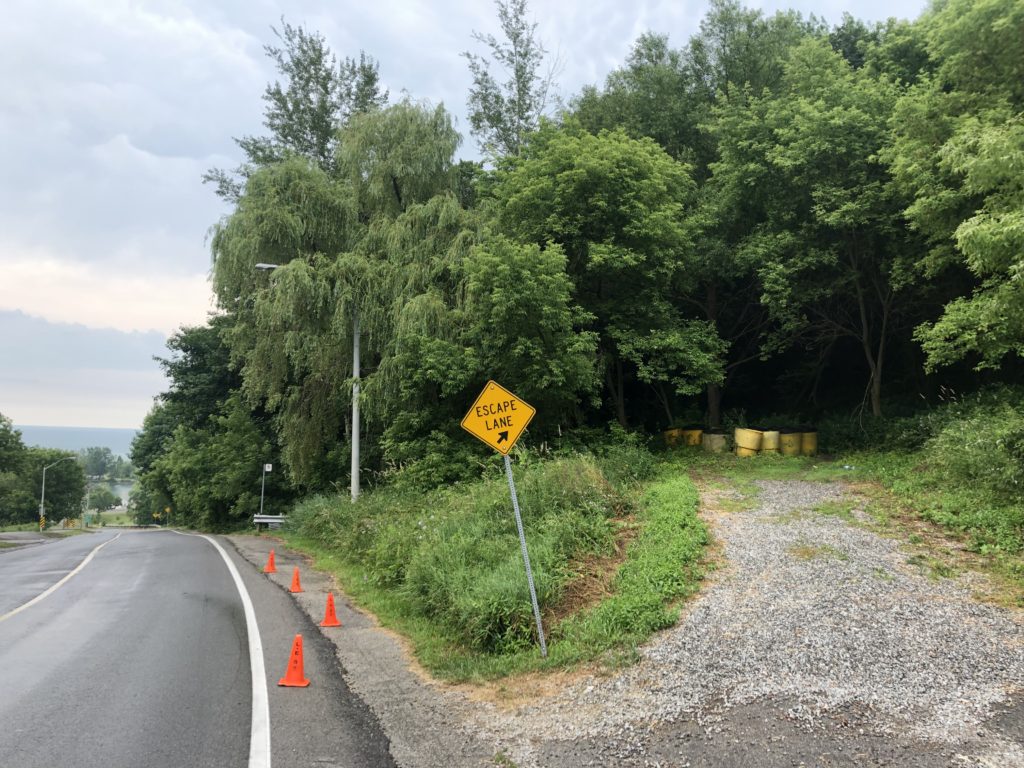
Once at the beach, the Blue Flag is flying there too and it remains relatively large despite the high water. I arrived after a thundershower, so the near-empty beach was just being repopulated, but on weekends the crowds are strong and they reflect the multicultural population of Toronto. The water here was warm, the sand soft, and the swimming was good. I could have stayed longer but I knew the tough bike ride up that hill would be slow.
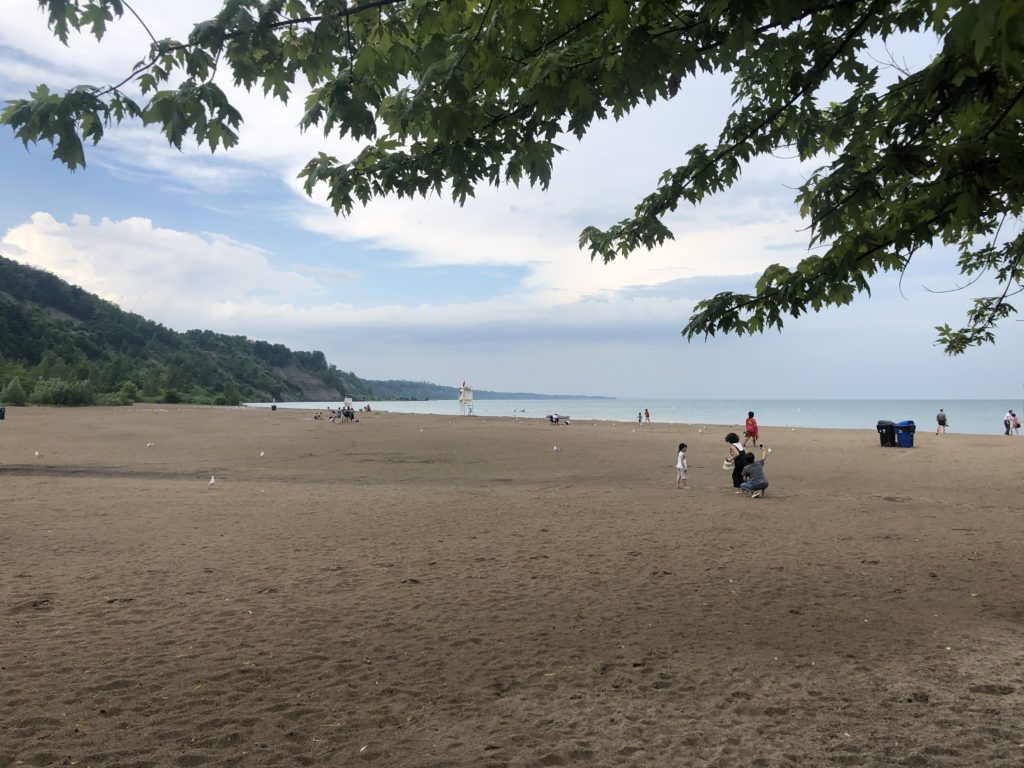
All across Toronto, the city is embracing its beaches and beach life, even if some people are still reluctant. For a few months of the year this is the kind of place where you can go for a dip after work or in between things, or just spend the day by the water, something we once had to travel hours to do. Now most trips to the beach are good days, unlike that first time at Sunnyside. Soon maybe I’ll swim there too.
Want to read more about Toronto’s beach culture? Check out Shawn’s twitter thread as he swam across Toronto’s beaches here.

